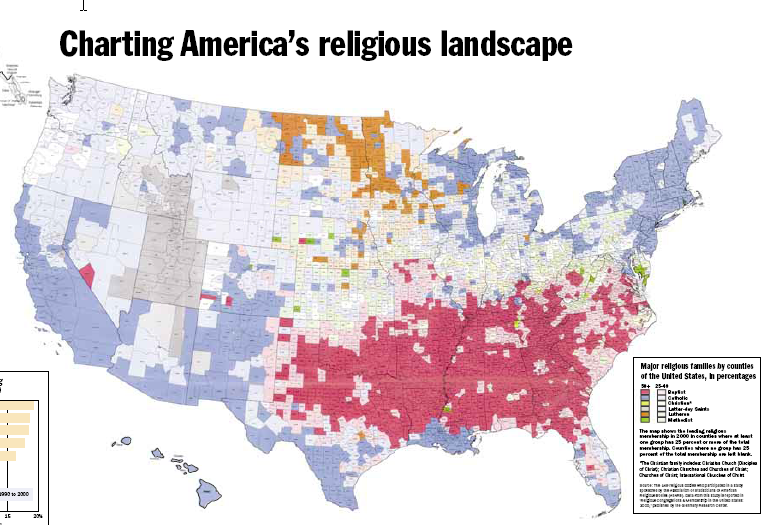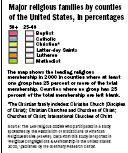
|
CHANGES IN DENOMINATIONAL PROFILES |
DENOMINATIONAL GROUPS
Liberal Protestants
United Church of Christ (Congregationalist, Evangelical and Reformed, Reformed United Church of Christ, United Church of Christ)
Presbyterians
Moderate Protestants
Lutherans
Christians (Disciples of Christ) -- Christian Disciples, Christian, Central Christian, Disciples of Christ, First Christian
Northern Baptists
Reformed -- Hungarian Reformed, Christian Reform, Dutch Reformed, First Reformed, Reformed, Grace Reformed
Conservative
Protestants
Churches of Christ
Evangelicals/Fundamentalists -- Evangelical Congregational, Independent Bible, New Testament Christian, Christian and Missionary Alliance, Eden Evangelist, Plymouth Brethren, United Brethren, United Brethren in Christ, Christ in Christian Union, Open Bible, Covenant, Evangelical, Evangelist, Evangelist Free Church, Salvation Army, Wesleyan, Wesleyan Methodist-Pilgrim, Evangelical Covenant, Mission Covenant, Swedish Mission, Fundamentalists
Nazarenes -- Holiness (Nazarene), Nazarenes
Pentecostals/Holiness -- Church of Prophecy, Apostolic Faith, Witness Holiness, Church of God in Christ, Church of God in Christ Holiness, Full Gospel, Four Square Gospel, Holy Roller, Holiness, Church of Holiness, Pilgrim Holiness, Pentecostal Church of God, Pentecostal, Pentecostal Holiness, Holiness Pentecostal, Sanctified, Sanctification, United Holiness
Assemblies of God
Churches of God
Adventists -- Advent Christian, Seventh Day Adventist
Black Protestants
Northern Baptists
Southern Baptists
Others
Jehovah's Witnesses
Christian Scientists -- Christian Science, Religious Science
Unitarian-Universalists -- Unitarians,
Universalists, Unitarian-Universalists
HISTORICAL DEVELOPMENT OF DENOMINATIONS IN THE U.S.
Religious pluralism was not desired our forefathers. It was adopted because
No church was strong enough to dominate
Sectarian groups were not strong enough to dominate
Government supported Christian values
The King James Bible was read in schools
Blasphemy was a punishable offense
Sabbath laws were enforced
Court decisions made reference to Protestant Christianity
There was an expectation that Christianity would become more unified
America’s mission was to convert the world
Sects later became to be seen as a revitalization of true religion
An unregulated, free market religious economy was the solution to competition among churches and sects
Religion became a matter of individual choice
CHANGES IN DENOMINATIONAL PROFILE: 1776-1850
The religious profile of the U.S. has changed dramatically historically
Mainline denominations have been declining since the late 18th century
The decline went unnoticed initially because
The overall population grew and mainline churches participated in that growth
The church membership rate increased from 17% to 34 %
Liberal Protestant church es continued to represent the privileged and powerful
Elite seminaries trained ministers
Media coverage of mainlines was respectful and posed no challenge
to their position
The first major shift in denominational loyalty occurred following
the colonial settlement
Percent of Adherents
Denomination
1776 1850
------------------------------------------------------
Congregationalists 20.4 4.0
Episcopalians 15.7 3.5
Presbyterians 19.0 11.6
Baptists 16.9 20.5
Methodists 2.5 34.2
Catholics
1.8 13.9
Causes of Shift
Some churches were unprepared to deal with a competitive religious economy
Highly educated clergy disdained competitive economy
Some churches were unprepared to move West
Episcopalians
and Congregationalists were hindered by a professional clergy, centralized
organization,
established churches
in the colonies, and more complex theology
Methodists and
Baptists were aided by clergy selected from parishioner ranks, democratic
organization,
efficient organization,
and a simple theology


CHANGES IN DENOMINATIONAL PROFILE: 1965-1985
Beginning in the 1960s mainline denominations experienced the first
absolute membership loses in their histories
% Change in
Denomination
Membership
----------------------------------------------------------
American Lutheran -08.2
Disciples of Christ -41.8
Episcopal -20.0
Lutheran Church -02.5
Lutheran Church in America -07.8
Presbyterian -23.5
United Church of Christ -18.6
United Methodist -16.3
*********************************
Assembly of God 116.0
Church of God 147.0
Church of Nazarene 52.0
Jehovah's Witnesses 121.0
Mormons 116.0
Seventh Day Adventists 79.0
Southern Baptists
34.0
Other types of religious groups grew as wel
New religious movementsTelevision ministries
Charismatic revival groups within denominations
Explanations for mainline losses
Conservative churches grew at the expense of liberal churches through switchingYouthful defections mounted in the 1960s as part of the protest counterculture
Baby boom children reached college age in the 1960s and 1970s